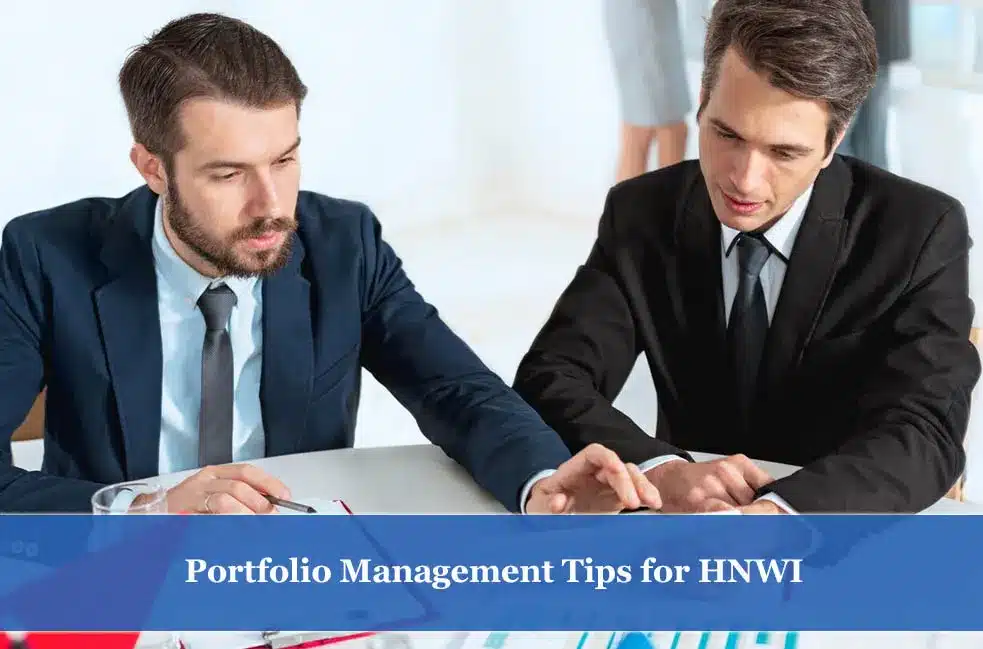Individuals with a high net worth (HNWIs) typically hold a significant amount of liquid assets available for investment, excluding personal use items such as primary residences, collectibles, or daily belongings. Their financial position often grants access to specialized investment opportunities and services not available to the broader public. While the definition of HNWI can vary by institution or region, it generally refers to those with at least $1 million in investable assets. Due to their unique financial profile, HNWIs often pursue tailored financial planning strategies encompassing estate planning, tax efficiency, and access to select investment vehicles.
Table of Contents
- What is High Net Worth Portfolio Management?
- What elements are found in portfolio management?
- Active vs Passive Portfolio Management
- Portfolio Management Tips for HNWI
- Mistakes to Avoid During Portfolio Management

What is High Net Worth Portfolio Management?
High Net Worth Portfolio Management (HNWPM) is a specialized approach to managing the financial assets of individuals with substantial investable wealth. This practice goes beyond basic investment transactions to provide a comprehensive framework that aligns all financial decisions with the broader goals and complexity of significant wealth.
HNWPM is necessary because high-net-worth individuals often face financial challenges and opportunities that differ from those of the average investor. Their portfolios may span global markets, alternative investments, multiple income streams, and intricate liabilities. Standard portfolio strategies often fall short of addressing these complexities. As such, HNWPM is not solely focused on maximizing returns—it is about building a strategic, customized plan that accommodates the unique needs, preferences, and risks associated with managing considerable wealth.

What elements are found in portfolio management?
1. Tax Planning
Tax planning plays a critical role in portfolio management for high-net-worth individuals (HNWIs). Large portfolios often come with complex tax implications. Strategic tax planning enables investors to minimize liabilities while remaining compliant with regulations. This may involve utilizing tax-advantaged investment vehicles, deferring gains, or capitalizing on favorable long-term capital gains rates. The primary goal is to preserve more of the portfolio’s returns and reduce tax drag on overall performance.
2. Diversification
Diversification involves allocating investments across various asset classes (e.g., equities, fixed income, real estate), sectors (e.g., healthcare, tech, energy), and regions (e.g., North America, Europe, Asia). This approach helps reduce exposure to the underperformance of any single area. Because different markets often move independently, diversification helps stabilize returns and mitigate volatility across the portfolio.
3. Asset Management
Effective asset management goes beyond buying and selling. It includes ongoing analysis of portfolio holdings in light of market trends, asset-specific performance, and shifts in economic conditions. For HNWIs, this can also include alternative investments like hedge funds, private equity, or venture capital. Asset management ensures alignment with financial objectives, whether growth-oriented, income-focused, or a blend of both.
4. Rebalancing
Over time, market movements can alter a portfolio’s intended allocation. Rebalancing is the act of restoring the original asset mix by adjusting holdings. For instance, if equities outperform bonds, the portfolio may become riskier than intended. Rebalancing involves selling portions of overrepresented assets and reallocating to underrepresented ones to maintain the desired risk profile and investment strategy.
5. Risk Management
Risk management identifies and addresses the various uncertainties associated with investing. This includes assessing exposure to market volatility, interest rate changes, geopolitical events, and more. Once risks are identified, strategies such as diversification, hedging with financial instruments, or adjusting asset allocations may be employed. For high-net-worth individuals, disciplined risk management is essential to preserve wealth and ensure long-term financial resilience.

Active vs Passive Portfolio Management
In investment strategy, active and passive portfolio management represent two widely adopted approaches, each with distinct advantages and limitations. The selection often depends on an investor’s goals, risk tolerance, and desired level of involvement.
Active Portfolio Management
- Definition: Active portfolio management involves a manager or investment team making informed decisions with the goal of outperforming a chosen benchmark index.
- Strategy: This approach requires continuous oversight. Managers analyze market trends, macroeconomic data, company fundamentals, and other indicators to decide when to buy, hold, or sell securities.
- Cost Structure: Because it entails in-depth research and frequent trading, active management typically carries higher costs. These include management fees, transaction expenses, and potentially higher tax liabilities due to turnover.
- Return Potential: The appeal lies in the possibility of exceeding benchmark performance. However, this also comes with greater risk and no guarantee of success.
- Flexibility: Active managers are not confined to tracking an index. This flexibility allows them to respond to market shifts, capitalize on emerging opportunities, or hedge against anticipated downturns.
Passive Portfolio Management
- Definition: Passive portfolio management, often referred to as index fund investing, involves building a portfolio designed to track the performance of a specific market index. Rather than attempting to beat the index, the goal is to replicate its returns as closely as possible.
- Simplified Approach: Once the portfolio is structured to mirror an index, it generally requires minimal ongoing management. Trades are typically only made when the index itself changes, reducing the need for frequent market-driven decisions.
- Cost Benefits: Because passive management involves fewer transactions and less oversight, it tends to carry lower management fees compared to active strategies. This can appeal to investors seeking a more cost-effective approach to private investment management.
- Steady Returns: Passive strategies may not aim for outperformance, but they do offer consistency. Investors can expect returns that broadly reflect the performance of the index being tracked, making this a practical strategy for long-term, steady growth.
- Transparency: Since the strategy is designed to follow a known index, investors can clearly see what assets are included and understand why. This transparency contributes to informed decision-making and aligns with the expectations of those evaluating fee-based investment advisors.

Portfolio Management Tips for HNWI
Navigating the complex landscape of portfolio management for high-net-worth individuals (HNWIs) requires a tailored, research-informed strategy that aligns with personal financial goals, shifting market conditions, and long-term planning.
Strategic Personalization
Significance: Each HNWI has distinct financial objectives, risk tolerance, and investment timelines.
Implementation: Portfolio construction should reflect these individual considerations. For example, someone in the early stages of wealth accumulation may pursue higher-growth opportunities, while someone nearing retirement may prioritize capital preservation.
Asset Class Diversification
Significance: Overconcentration in a single asset class or sector can elevate portfolio risk.
Implementation: Distributing capital across a mix of equities, fixed income, and other asset types can help reduce exposure to market-specific downturns and promote stability.
Exploration of Alternative Investment Avenues
Significance: Traditional investments only represent part of the opportunity set for private investment management.
Implementation: Including alternative assets such as private equity, real estate, or hedge funds may enhance diversification and introduce differentiated return profiles into the portfolio.
Tax-Efficient Portfolio Design
Significance: Poor tax planning can diminish portfolio gains over time.
Implementation: Conducting regular tax reviews and incorporating tax-efficient strategies, such as tax-loss harvesting or utilizing tax-deferred accounts, can help maximize after-tax returns.
Systematic Portfolio Rebalancing
Significance: Asset allocation can shift over time due to market movement.
Implementation: Periodic rebalancing helps maintain alignment with the original investment strategy, ensuring that risk exposure remains consistent with the investor’s intent.
Robust Asset Security Protocols
Significance: With increased reliance on digital platforms, security has become a critical concern for high-net-worth portfolios.
Implementation: Applying strong cybersecurity practices, secure digital communication methods, and proper insurance for tangible assets can strengthen overall asset protection.
Engagement with Industry Experts
Significance: Managing significant wealth often requires input beyond generalist advice.
Implementation: Collaborating with specialized advisors, tax professionals, and investment analysts can support more informed decision-making and refined portfolio strategies.

Mistakes to Avoid During Portfolio Management
- Overconcentration: Allocating too much of your portfolio to a single asset or group of related assets can expose you to unnecessary risk. While it’s natural to have confidence in certain investments, overexposure to one sector can result in significant losses if that area underperforms. Diversifying across various asset classes is a fundamental strategy in private investment management to help reduce volatility and improve long-term consistency.
- Ignoring Tax Implications: Tax consequences can significantly impact overall investment returns. For example, selling a long-held asset may trigger capital gains taxes, reducing your net profit. Without a tax-aware strategy, fee-based investment advisors and investors alike may overlook opportunities to preserve more of the portfolio’s growth. A tax-efficient portfolio approach is especially critical for high-net-worth individuals aiming to optimize after-tax results.
- Following Trends Blindly: Investment fads come and go, and chasing the “next big thing” without due diligence can lead to misaligned choices. Not every trending asset fits your risk profile or long-term strategy. It’s essential to evaluate whether a particular trend complements your broader portfolio objectives rather than reacting impulsively to market hype.
- Neglecting to Review: Markets evolve, and so should your portfolio. What may have worked a year ago could now be out of sync with your financial goals or market conditions. Regular portfolio reviews help identify underperforming assets and ensure your allocation remains aligned with your current investment strategy. This is a key step in maintaining a responsive and effective portfolio.
- Overlooking Fees: Returns must be considered in light of associated costs. Advisory fees, fund management costs, and trading charges—if unchecked—can gradually diminish your portfolio’s growth. High-net-worth investors often benefit from reviewing these expenses closely to ensure long-term cost efficiency without sacrificing quality investment options.
While general financial knowledge is widely available, navigating the intricacies of portfolio management—especially for large portfolios—often calls for professional insight. Independent investment firms and qualified advisors bring specialized experience that can help interpret complex markets, structure strategies, and identify opportunities that might otherwise be missed.
By staying mindful of these potential pitfalls, high-net-worth investors can strengthen their long-term financial outlook and better support their evolving wealth management goals. If you’re seeking guidance on where to begin or how to refine your strategy, our platform offers tools to help you make informed decisions.
Frequently Asked Questions
How does high-net-worth portfolio management differ from standard portfolio management?
High-net-worth portfolio management typically incorporates more advanced strategies, including tax optimization, estate planning, access to alternative investments, and broader diversification. These approaches are tailored to the complexities of managing substantial assets.
Why is diversification crucial for HNWIs?
With larger portfolios, the impact of underperformance in any single investment can be magnified. Diversification helps reduce that exposure by spreading risk across different asset classes, which may contribute to more stable long-term outcomes.
Are alternative investments a common consideration for HNWIs?
Yes. Many high-net-worth individuals explore private investment management strategies involving alternatives like real estate, hedge funds, private equity, or commodities. These can provide additional diversification and may offer distinct return profiles not typically available through traditional investments.
What role does tax planning play in high-net-worth portfolio management?
Tax planning is a key component. For individuals with significant wealth, strategic tax management—such as capital gains timing, asset location, or trust structures—can reduce liabilities and help preserve overall portfolio value.
How often should HNWIs rebalance their portfolios?
While there’s no one-size-fits-all answer, it’s generally advisable to review and rebalance a portfolio semi-annually or annually. The right frequency depends on factors like investment goals, risk tolerance, and market movement.

